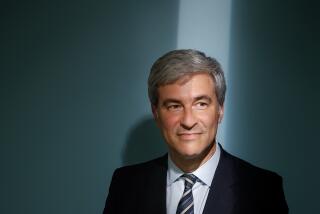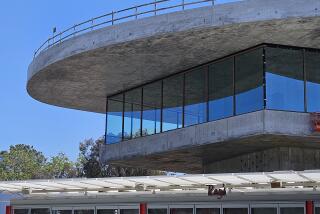Critic’s Notebook: Broad Collection may borrow prestige from MOCA
When multibillionaire businessman, art collector and philanthropist Eli Broad was asked in June whether he was maneuvering to take over Los Angeles’ celebrated but troubled Museum of Contemporary Art, he minced no words in reply.
“Categorically, no,” he told The Times.
I believe him. Broad is in the midst of building a $130-million vanity museum on Grand Avenue. What he actually seeks is validation as an art collector in his own right. A vibrant, internationally admired and nominally independent MOCA across the street is a supporting player in that project.
In the tumult surrounding MOCA over the last six months — an erratic art program, grim staffing issues, real funding problems, sharp divisions among trustees, etc. — the Broad takeover myth has become deeply entrenched. But it makes no business sense, and Broad is nothing if not a savvy businessman.
MOCA: Meet the Board | Meet the billionares | Museum donors’ roll
Why go to the expense of taking over a major art museum when you’ve already got effective control of it? Broad’s influence at MOCA is already decisive.
He’s a life trustee. He handpicked the museum’s controversial director, New York gallery owner Jeffrey Deitch. He, not the director, delivered the termination news to the museum’s long-standing chief curator, Paul Schimmel — the June event that caused long-simmering bad news to boil over. He evaluates planned exhibitions, checking off those he finds worthy of support. The spouses of both MOCA co-chairs sit on boards of Broad charities.
Most important, the Broad Foundation pledged $30 million to begin to resolve MOCA’s 2008 funding scandal, a jaw-dropper that had seen trustees sign off on spending down most of the museum’s endowment. Thirty million is a good chunk of change — although it pales in comparison to the dollar value of other MOCA donors’ art gifts over the years. For a man of Broad’s vast personal wealth, estimated by Forbes at $6.3 billion, it’s also relatively modest — the rough equivalent of a $500 or $600 pledge from a median American household.
Paid out over a minimum of five years, it barely dents his foundation. According to its most recent tax filing, the 2010 payment represented just over 4% of total Broad Foundation grant distributions. For comparison, that $5 million was barely half what the foundation established by Charles R. Schwab, chairman of the San Francisco Museum of Modern Art, gave to his museum that year — and again the year before. Schwab is wealthy, but not as wealthy as Broad.
Still, Broad deserves his due. At a moment of maximum crisis for MOCA, when its future was in serious doubt, his pledge far outpaced other cash gifts. That carries legitimate clout.
MOCA: Meet the Board | Meet the billionares | Museum donors’ roll
The legal document for his museum pledge does include requirements for MOCA to identify him as “founding chairman of the board” and to recognize the Broad Foundation as the biggest cash donor in the museum’s history. The tight MOCA connection surely stoked the erroneous takeover myth.
It also created another problem, thanks to Broad’s well-known penchant for marquee publicity. When one billionaire is so closely linked in the public mind to an institution, potential benefactors might wonder why their help is needed — especially to underwrite another person’s pursuit.
Broad has a long, complicated history on cultural boards, including rocky trustee stints at the Los Angeles County Museum of Art, the UCLA Hammer Museum and MOCA back in the 1980s and 1990s. The collective task of governing, which is what museum trustees do, is not his long suit. It isn’t the same as unilaterally running a business, which is where his prodigious skill set lies.
Broad needs no validation as a businessman. At 79, he’s got 6.3 billion objective votes of confidence on that. End of discussion.
Validation as an art collector is more elusive. There, voting is subjective — even when validation comes from the art market.
Measured in dollars, the Broad Collection is currently regarded as a masterpiece, stuffed with works for which only the richest buyers can compete. Still, the success of his museum, set to open in 2014, is by no means assured. Big chunks of his 2,000-piece collection look great and big chunks look uncertain — at best. Critical approval is mixed.
As a prime example, take his two dozen Andy Warhol paintings and drawings. These erratic holdings don’t distinguish between the artist’s brilliant 1960s work and the steep decline in quality after the mid-1970s. Broad’s mixed bag seems driven less by critical rigor than by art-market ministrations: According to Reuters finance blogger Felix Salmon, Warhol alone accounted for an astounding 12% of the entire contemporary art auction market between 2000 and 2010.
Not that the general public will much care. Public approval is like market validation — a majority verdict — and the public instantly recognizes the Warhol brand.
A classic civic booster, Broad has claimed that L.A. is now the global center of contemporary art. That isn’t true — although L.A. is an equal to Berlin, London, New York and Beijing in today’s happily multicentered scene. (Note: Just 15% of the Broad Collection’s artists work here.) Yet he places MOCA and Grand Avenue at the fiction’s heart, so he’s placing his own museum there too.
A visit to the new Broad Collection will, for locals as for tourists, likely be a one-time thing — unless popular changing exhibitions at MOCA can keep foot traffic crossing the street. An announced $10 Broad admission is also planned to gain a visitor access to MOCA; but isn’t an admission fee to a billionaire’s museum wholly unnecessary? Limiting entry to paying customers inhibits the civic and educational value of the project. The unspoken assumption is that only a financial transaction makes an art experience truly meaningful.
So the problem Broad faces is this: How can an inconsistent personal art collection, based almost entirely on judgments derived from a commercial market, get a desirable veneer of public stability and critical approval? Answer: For reinforcement, call in some revered Old Masters from across the street.
An exquisite 1949 Jackson Pollock drip-painting, a couple of landmark 1950s Robert Rauschenberg “combines,” a few of Mark Rothko’s greatest abstract fields of floating color — these and more are there for the borrowing from MOCA’s widely admired collection. Their reputations are settled.
During the 2008 bailout negotiation, Broad demanded a formal MOCA loan arrangement as part of the deal. Many of MOCA’s most prominent art donors strongly resisted it. They correctly reasoned that their gifts were made to a promising public museum, not to help validate a billionaire’s private collecting tastes, and they dug in their heels.
The demand was dropped. Now, Broad’s influence at MOCA likely makes the absence of a formal arrangement moot.
Smart museums don’t just collect art, they collect art collectors. MOCA has been exceptionally successful at it. Giuseppe Panza, Taft and Rita Schreiber, Phil and Bea Gersh, J. Patrick Lannan, Barry Lowen, Marcia Weisman, Laura Lee Woods, Blake Byrne, etc. — their hundreds of gifts and acquisition underwriting created a remarkable museum in a single generation’s time.
Broad — “founding chairman of the board” — resisted being one of them. So now the Broad Collection means to collect art collectors too. Validation from proximity to Panza, Schreiber, Gersh, Lannan, Lowen, Weisman, Woods, Byrne, etc. wouldn’t flow from a crude museum takeover. But it’s certainly there for the borrowing.
More to Read
The biggest entertainment stories
Get our big stories about Hollywood, film, television, music, arts, culture and more right in your inbox as soon as they publish.
You may occasionally receive promotional content from the Los Angeles Times.











